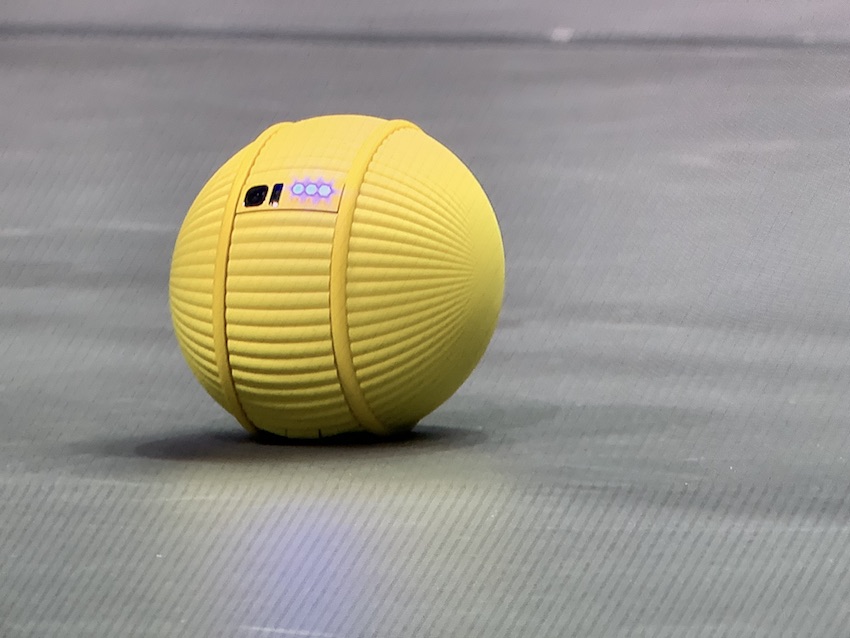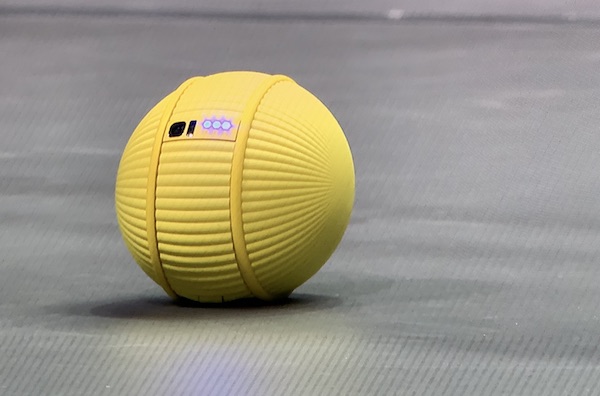Samsung Ballie is a Social Robot That Might Actually Be Useful and Scalable

Samsung Ballie – photo credit Voicebot.ai
It’s easy to look at Ballie, a cute little pastel-colored social robot demonstrated by Samsung Monday night at a CES keynote, and wonder if it is just another gadget with no better purpose than other social robots that have come and gone.
Smart speakers and smart displays have filled the role that was expected by many to be played by stationary robots such as Jibo. Radical simplification enabled smart speakers to provide most of the features anticipated for social robots and then went beyond that template at as little as one-twentieth of the price. If you want to know what killed the promise of social robots, look no further than Amazon Echo and Alexa.
A Robot That Follows You Around and Patrols Your Home When You Are Away
Ballie will follow you around, as demonstrated during the keynote by HS Kim, Samsung Consumer Electronics president and CEO. “I love this guy. He even knows to give me a little space,” Kim said as Ballie followed him around the stage, speeding up and slowing down to keep an appropriate distance. Kim went on to say, “Samsung’s vision is more than a cute robot.” Instead, the company wants to introduce, “robots that you know, support you and take care of you, so you can take care of what really matters.” This turned out to be a broader theme for Samsung about making products that help people in their daily lives.
Sebastian Seung, EVP, chief research scientist of Samsung Research commented, “of course we want Ballie to be fun. We also want Ballie to keep our home secured. We want AI we can trust…Ballie is a remote control that helps seniors connect with all of the smart devices in their home. It patrols your home…It has a camera to capture life’s special moments.” In short, Ballie can do a lot of things, potentially, but even Samsung seems unsure of just what its key applications will be.
Do You Need a Robot in an Ambient World?
If we are heading toward more ambient computing with voice assistants embedded in the world around us, what is the purpose of a little robot that rolls around behind us? That is less clear, but it does add vision capabilities, the immediacy of being where you actually are and take in more information about your environment. Amazon is reportedly developing its own robot for the same reasons. Rohit Prasad, head scientist of the Alexa artificial-intelligence group at Amazon, posed a question about why Alexa was not smarter in early 2019. He said he came to the conclusion that:
The only way to make smart assistants really smart is to give it eyes and let it explore the world.
A robot that can explore space clearly is able to take in more information and as a result, may be able to develop a more personalized experience for users. It’s not clear that the value of this added information will make a meaningful impact on consumers’ lives, but it does make a mobile robot with a voice assistant embedded and independent of other devices potentially more useful and definitely more knowledgable.
A Robot with Agency
Samsung is also looking beyond simple request-and-response interactions of earlier social robots and smart speakers. Demonstrations of Ballie show it identifying problems in the home such as spilled food and a tipped over plant. In both cases, Ballie proactively called a robot vacuum or air purifying system to the location of the problem. There was no requirement for the homeowner to take action or even know an issue had taken place.
Another example involved Ballie observing a demonstrator watering a household plant. The woman’s task list for that day included, “Water Plants” and Ballie automatically checked off that task as complete. These are examples of virtual assistants with agency. That means they are granted authority to take actions on behalf of the user even without an explicit command. Google Duplex and the forthcoming Ring Doorbell Concierge are other early examples of voice assistants with agency. This is clearly a feature set that the leading voice assistant providers assume will be important and beneficial to users.
No Bixby in Earshot
Ballie does respond to voice commands but is not powered by Samsung’s Bixby. There is some other proprietary speech recognition system embedded in the device, but it doesn’t talk back. It looks like a mobile app will be the primary means for feedback other than a few LEDs next to the camera.
Samsung Can Bring Scale to Robot Distribution
A key failing of consumer robots to date is not just the functionality but also the price point. That is where Samsung may have the biggest impact. The small form factor of Ballie will help keep material costs lower than the larger devices with more parts and physical scale and Samsung can build and distribute them at considerable volume. The cost benefits of producing millions instead of thousands may bring the cost down far enough that it won’t be a significant barrier to adoption. Smart speaker pricing at under $50 certainly helped drive faster adoption of the devices and a low-cost social robot under $200 might just do the same.
Samsung has not announced pricing or availability for Ballie but it does offer an indication of the direction the company is heading. The Star Wars vision of robots in different form factors is clearly a future the company is embracing. It may even arrive in market before the perennially delayed Galaxy Home smart speaker. That would be news.
Follow @bretkinsella Follow @voicebotai









